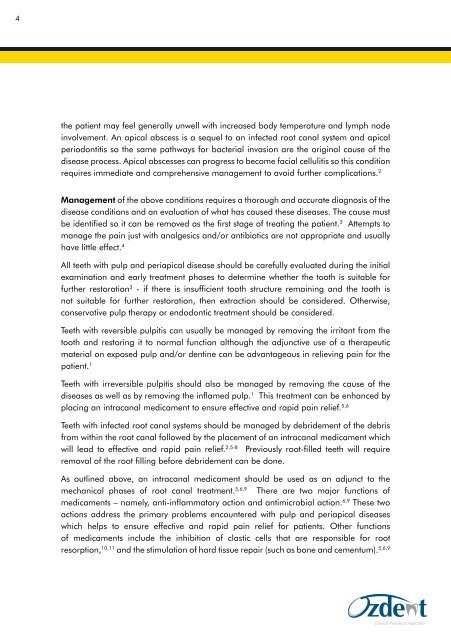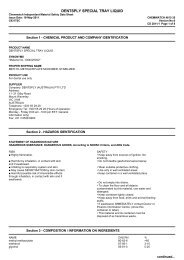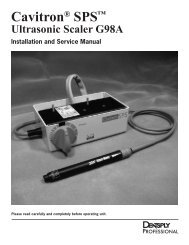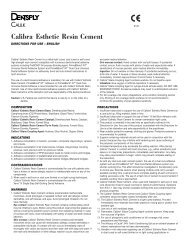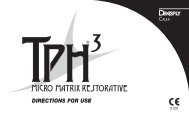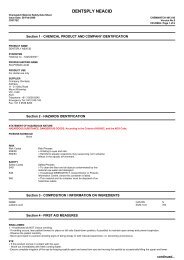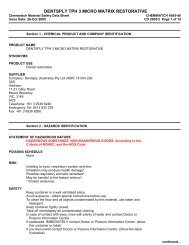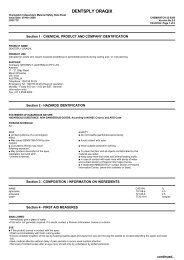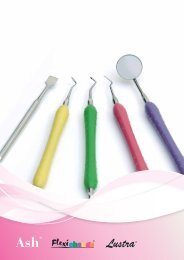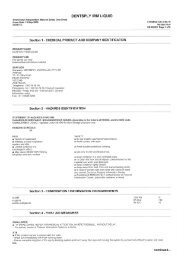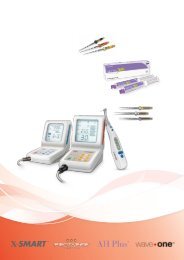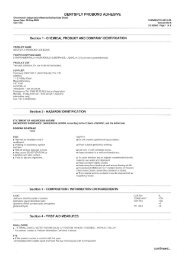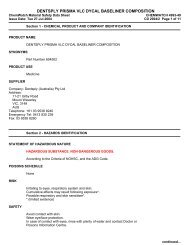The Materials - Dentsply
The Materials - Dentsply
The Materials - Dentsply
Create successful ePaper yourself
Turn your PDF publications into a flip-book with our unique Google optimized e-Paper software.
4 5<br />
<strong>The</strong><br />
<strong>Materials</strong><br />
the patient may feel generally unwell with increased body temperature and lymph node<br />
involvement. An apical abscess is a sequel to an infected root canal system and apical<br />
periodontitis so the same pathways for bacterial invasion are the original cause of the<br />
disease process. Apical abscesses can progress to become facial cellulitis so this condition<br />
requires immediate and comprehensive management to avoid further complications. 2<br />
Management of the above conditions requires a thorough and accurate diagnosis of the<br />
disease conditions and an evaluation of what has caused these diseases. <strong>The</strong> cause must<br />
be identified so it can be removed as the first stage of treating the patient. 3 Attempts to<br />
manage the pain just with analgesics and/or antibiotics are not appropriate and usually<br />
have little effect. 4<br />
All teeth with pulp and periapical disease should be carefully evaluated during the initial<br />
examination and early treatment phases to determine whether the tooth is suitable for<br />
further restoration 3 - if there is insufficient tooth structure remaining and the tooth is<br />
not suitable for further restoration, then extraction should be considered. Otherwise,<br />
conservative pulp therapy or endodontic treatment should be considered.<br />
Teeth with reversible pulpitis can usually be managed by removing the irritant from the<br />
tooth and restoring it to normal function although the adjunctive use of a therapeutic<br />
material on exposed pulp and/or dentine can be advantageous in relieving pain for the<br />
patient. 1<br />
Teeth with irreversible pulpitis should also be managed by removing the cause of the<br />
diseases as well as by removing the inflamed pulp. 1 This treatment can be enhanced by<br />
placing an intracanal medicament to ensure effective and rapid pain relief. 5,6<br />
Teeth with infected root canal systems should be managed by debridement of the debris<br />
from within the root canal followed by the placement of an intracanal medicament which<br />
will lead to effective and rapid pain relief. 2,5-8 Previously root-filled teeth will require<br />
removal of the root filling before debridement can be done.<br />
As outlined above, an intracanal medicament should be used as an adjunct to the<br />
mechanical phases of root canal treatment. 5,6,9 <strong>The</strong>re are two major functions of<br />
medicaments – namely, anti-inflammatory action and antimicrobial action. 6,9 <strong>The</strong>se two<br />
actions address the primary problems encountered with pulp and periapical diseases<br />
which helps to ensure effective and rapid pain relief for patients. Other functions<br />
of medicaments include the inhibition of clastic cells that are responsible for root<br />
<strong>The</strong> LEDERMIX ® materials were developed in 1960 by Prof. Andre Schroeder from<br />
Switzerland. <strong>The</strong>re is a paste form and a cement form of this material. Both of these<br />
materials have been widely researched and used extensively in clinical practice since<br />
becoming commercially available in 1962. A wide range of researchers and clinicians<br />
have investigated and reported the use of these materials. A partial list of these articles<br />
is included in this booklet 7,8,10-27 and readers should be aware that there are numerous<br />
other articles in the dental literature which support the use of these materials.<br />
Although the two forms of Ledermix have different uses in Dentistry, they have two<br />
common active components, triamcinolone (a corticosteroid) and demeclocycline (a<br />
tetracycline antibiotic). <strong>The</strong> bases in which these components are presented dictate the<br />
way each material is used and their indications for use.<br />
LEDERMIX Paste is formulated to be used as an intracanal medicament with a watersoluble<br />
paste base. 18 It is presented as a single paste in a tube so there is no need to mix<br />
this material prior to use. 28<br />
LEDERMIX Cement is a hard-setting material for use on dentine as a lining, as a pulp<br />
capping agent and as a pulpotomy agent. 16 This material is presented as a powder and<br />
a liquid that must be mixed immediately prior to use in a tooth. 28 <strong>The</strong>re are two forms of<br />
the liquid component – a fast-setting formulation and a normal setting formulation – and<br />
the majority of the liquid is eugenol (85%). 27,28 <strong>The</strong> powder component contains zinc oxide<br />
(47.2%) and calcium hydroxide with the latter making up 33.4% of the powder. 27 Once<br />
the powder and liquid are mixed, the cement is a zinc oxide-eugenol cement containing<br />
triamcinolone, demeclocycline and calcium hydroxide as its active ingredients. 27<br />
Triamcinolone is used in the LEDERMIX materials because of its anti-inflammatory<br />
action which assists with rapid pain relief following the commencement of treatment. It<br />
also inhibits clastic cells (osteoclasts, cementoclasts and dentinoclasts) and therefore it<br />
can be used to manage root resorption. 6,10,11 <strong>The</strong> triamcinolone is present in LEDERMIX<br />
Paste at a concentration of 1.0% 9,18 and in LEDERMIX Cement at a concentration of<br />
0.67%. 16,27<br />
resorption, 10,11 and the stimulation of hard tissue repair (such as bone and cementum). 5,6,9 <strong>The</strong> <strong>Materials</strong>


